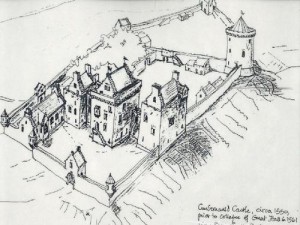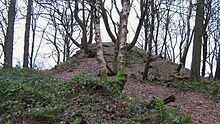The Flemings of Cumbernauld Castle
Cumbernauld Castle, the home of an important medieval Fleming family, occupied a strategic position in the centre of Scotland. In its day the castle was probably one of the largest in Scotland. Today not much can be seen of its remains but it is hoped that shortly-to-be-commissioned archaeological research will shed light on the size and structure of the castle. This blog posting, mainly the work of Adam Smith, looks at the history of the castle and the Flemings that occupied it.
The Castle and Other Structures
Cumbernauld castle, built by a Fleming family in the 14th century, would have been one of the largest castles in Scotland in its day, covering some 9 acres of land (see mock up below of how the castle may have looked). Likely the castle would have initially comprised a strong stone tower in the form of an L-Plan (a rectangular block with a wing projecting at the end of one of the long sides) with timber or stone outhouses attached. Today not much of it remains apart from a small section of its original wall.

Some of the stone from the castle was used to build Cumbernauld House (see photo below), a country house that was constructed in 1731 for John Fleming, the 6th Earl of Wigtown. The house sits on the former grounds of the castle and is a category A listed building. During the 20th century it went through a range of uses, including office space for the now defunct Cumbernauld Development Corporation. The house has recently been restored and developed into flats under strict regulations set by the current council.

Another interesting feature of the area around the castle was a motte and bailey castle that was constructed by the Comyn family. Today only the motte remains and this is shown in the photo below. The Cumbernauld area was originally part of the Comyn’s barony of Kirkintilloch.

The Fleming Family and the Castle
The Comyns were one of the most powerful families in Scotland and the chief supporters of Edward I of England in Scotland during the early stages of the Wars of Independence. Robert the Bruce met John Comyn, head of the family, at Greyfrairs Kirk in Dumfries in 1306. The two argued and Bruce stabbed and killed Comyn. Robert Fleming was one of two companions to Bruce that day, and a staunch supporter of him. To provide proof that Comyn was dead, Fleming cut off his head in order to “let the deed shaw”, a Fleming family motto ever since.
Robert Fleming came from the Fleming family of Biggar (the subject of a blog posting on March 24, 2014), a well-established family. Robert was the son of the Lord of Biggar. Robert died prior to Bannockburn but a grateful Bruce knighted his son, Malcolm. Malcolm was also granted the barony of Kirkintilloch and a significant amount of former Comyn land.
Sir Malcolm Fleming came under threat, after Bruce died in 1329, from Edward Balliol and Scottish lords of the Comyn faction (with the support of English king Edward III). This threat intensified following the battle of Halidon Hill in 1333 and an English invasion. But Sir Malcolm survived and his son, also a Sir Malcolm, subsequently inherited the barony. Around 1371 he turned his attention to a consolidation of the barony and centering its activities towards the more strategic Cumbernauld and away from Kirkintilloch. As a result Cumbernauld Castle was built.
The castle played host to a number of royal visitors over the years, including Mary Queen of Scots. It was during her visit on 26 January 1562 that the Great Hall of the castle collapsed (while the Queen and her entourage were out hunting). 7 or 8 men were killed. The Queen visited the families of the men killed or injured in the accident. The Fleming link with Mary was very close because one of her four close companions (the four Maries) was the daughter of Lord Fleming, a descendant of Sir Malcolm.
Early in the 17th century, following the accession of James VI as James I of England, the King acknowledged the services that the Flemings had rendered to himself and family. In 1606 the Earldom of Wigton was bestowed upon John, the 6th Lord Fleming.
The end of the Cumbernauld Castle came at the hands of Oliver Cromwell’s troops some time after 1650. It was one of the fortresses in Scotland that “Cromwell knocked about a bit”.
Excavations of the Castle and Plans for a New Archaeology Project
During the period 1963-4 an excavation was carried out by the Cumbernauld History Society on Cumbernauld Castle, revealing the remains of a prison and cellar, a 15th century rubbish chute and a 17th century wellhouse. When the excavation was completed it was filled in again. In 1981-2 Cumbernauld and Kilsyth District Museums excavated another part of the castle. They discovered a cobbled courtyard, the base of a circular building and part of the wall.
It is hoped that the Friends of Cumbernauld House Park will soon commission a Community Archaeology Project to investigate the belief that Cumbernauld Castle was once one of the largest in Scotland. With the previous excavations having been completed in an era when the only mode of archaeological investigation was to dig, this project will utilise modern technology, for the first time presenting a complete picture of the Castle remains which lie hidden beneath Cumbernauld House Park. This investigation, and the resulting excavations, will not permanently uncover a new historic structure, but will serve a much greater community education purpose, enabling countless people from all over the world to learn of the history of Cumbernauld Castle and a glimpse into the life of its former Fleming residents.
Adam Smith and Alex Fleming
Adam Smith is Chair of the Friends of Cumbernauld House Park and the Chair of Cumbernauld Community Development Trust.
References
Millar, Hugo B. The History of Cumbernauld and Kilsyth from Earliest Times. Cumbernauld Historical Society, 1980
www.oxforddnb.com/templates/article.jsp?articleid=9701&back=&version=2004-09
Cumbernauld Castle – Wikipedia
North Lanarkshire Council Archives
Cumbernauld Museum